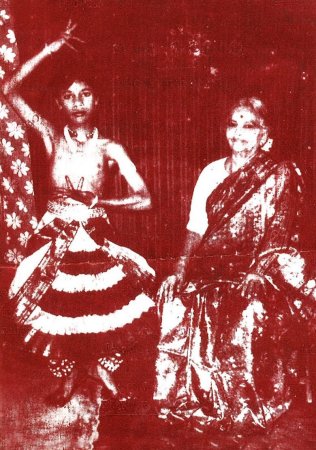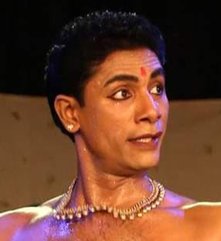 |
  |
 |
  |
T.A. Rajalakshmi Ammal: A fountain of hereditary repertoire - M. Venkatakrishnan e-mail: gmvkrish@yahoo.co.in June 21, 2023 It was in the year 1989 that I started learning from Thiruvidaimarudur T.A. Rajalakshmi Ammal. After she came back from Calcutta, she was staying in Pattinapakkam, Chennai. Then she moved back to her native place in the early 80’s and that is when she started teaching at Janaranjani Sabha, Kumbakonam. Unfortunately, one day she fell from the bus and had a knee injury. She could barely walk after that and that’s when she decided to teach at her own place in Thiruvidaimarudur. That is when I started learning from her. There were four of us who did arangetram under her and I was the only boy in that group. I was 7 years old and had no idea what Bharatanatyam was. It was simply my father’s wish so I learnt this art form from her. Because of the knee injury she was not able to stand and teach. She always sat and taught me. There was always a vilakku (lamp) lit up 24/7 just above the bed where she sat and taught, where she also slept and rested. Pointing to the lamp, she often said, “My beloved is there; when will he take me along with him?” Of course, a Nataraja statue was behind the lamp. As a 7 year old boy I had no idea what she was talking about, but now I could imagine, coming from the Devadasi tradition what she meant and her belief of marrying the Lord (Pottukettal). My father helped her to write to India Today magazine; they came and interviewed her and it got published. It was three years after I had started learning from her, she called my parents and said I would be ready to do arangetram in a year. Even though she was not too mobile, her vigor and her teaching methods made me learn a margam in a year and I did my arangetram with her blessings. She herself did nattuvangam sitting on a chair at Janaranjani Sabha, Kumbakonam on September 1, 1993. If not for her efforts in making me do an arangetram I wouldn’t have pursued Bharatanatyam as my profession. She was a bold woman but a child at heart.  After my arangetram, for some time I continued learning from her. Age caught up with her and she fell sick, so she advised me to continue training in Kumbakonam, where I started learning from Muthuswamy Selvam, son of Guru V.S. Muthuswamy Pillai. Even though I stopped going to her for classes, my mother and she were always in touch. Our house was a kilometer away from hers, and since she could not walk, she wrote to my mother on a 15 paise post card and asked her for meen kuzhambu (fish stew) and dry fish (her favorite dish) because I used to take it to her whenever my mother made it at home while I was going to her classes. She stayed alone all by herself. She used to tell my parents that she wanted to leave this world peacefully, no dramatic noisy rituals. As per her wish, after she passed away on June 4, 2003, there were no dramatic rituals. A quiet ceremony and she left peacefully. T.A. Rajalakshmi Ammal and her family followed Thanjavur baani (style). She was brought up in the atmosphere of Nadhaswaram and Thavil hereditary artistes. So music was equally important as how seriously she pursued her Bharatanatyam training from Kuppiah Nattuvanar. Thiruvidaimarudur Veerusamy Pillai lived next to her house. It was a tradition in Thanjavur district that the artiste families, especially Nadhaswaram and Thavil artistes, stayed close to each other. They would come to one of the senior artiste’s house and practice or learn a same set of songs through the family repertoire. In that sense, she learnt many Tanjore Quartet varnams. Her favourite was “Dhaanike thakuja” in Thodi ragam, which I also learnt and performed for my arangetram. After she settled in Thiruvidaimarudur, there were many Nadhaswaram artistes who used to come and learn some rare padams from her. As per her advice, I started learning music from Nadhaswara vidwan Govindaraj who was staying in the front portion of her house. “Aasai kollaadavar illaye” in Kamboji ragam, a special piece in her repertoire with Navarasas has been performed around the pot - walking as virutham and then the song performed on the pot (paanai mel nadanam, as she called it). And she herself performed Kuttrala Kuravanchi in her prime days, so there was always a kuravan or kurathi piece extracted from those Natya natakams (dance dramas). She knew most of the Tanjore Quartet sabdams. I did a Ragamalika sabdam for my arangetram and a Paambu nadanam (snake dance) in Punnagavarali ragam after Thillana. The paanai mel nadanam (pot dance) and paambu nadanam (snake dance) are janaranjaka pieces added to the repertoire, which were well received by the rural audience. The first half of the repertoire was always strictly with kauthuvam, alarippu, jathiswaram, sabdam, varnam. The second half started with padam, keerthanai, then variety items like pot dance and snake dance were added to the repertoire. She taught only in the morning starting at 6am. And she would not teach for a long time. Half an hour or maximum 45 minutes, that’s it. She never taught me to recite the jathis; she would recite the thathakaram (a complicated jathi uttered in simple rhythmic beats) alone and we had to go with the calculation. Only for sahityam she sang, otherwise only thathakarams. She encouraged the students to sing and perform for the sahitya portions. It was helpful for expressions and somehow you became 20% of a singer. She was one of those hereditary dancers who followed most of the compositions of the Tanjore Quartet. She was a treasure trove for many dancers and musicians post independence.  M. Venkatakrishnan is an alumnus of Bharata Kalanjali under the Dhananjayans and performed extensively in and outside Bhaaratam with his gurus. He now concentrates more on teaching natyam, composing jathis, doing and teaching nattuvangam. He writes poems in Tamizh and Samskritam and composes music for natya items. Post your comments Please provide your name and email id along with your comment. All appropriate comments posted with name and email id in the blog will also be featured in the site. |